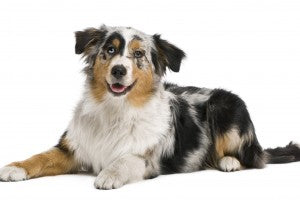
The Australian Shepherd: A Faithful Companion
The Australian Shepherd is a loyal, affectionate and intelligent dog that adapts well to family life. In this article, we explore in detail the origins, needs and particularities of this dog breed, always recognized for its qualities as a "shepherd dog".
The origins of the sheepdog
Contrary to what its name suggests, the Australian Shepherd does not come from Australia. Rather, it was born in America.
This breed was developed for herding in the western United States. Ranchers and farmers in the early 19th century strove to create a versatile, hardworking, and intelligent dog capable of herding livestock.
There are many theories about the breeds that were used to create this herding dog. It is likely that its ancestors include collie and shepherd-type dogs that were imported to North America with shipments of sheep from Australia during the 1840s – hence its name.
The breed experienced a boom in popularity in the postwar years, as interest in Western-style horsemanship grew. Crowds at rodeos and horse shows, as well as viewers of movies and television shows, were enchanted by the athletic dogs they saw working alongside cowboys.
Today, the Australian Shepherd remains the same energetic and intelligent dog that proved so useful to ranchers and farmers in the West. He is a wonderful family companion, protective and loyal!
Physical characteristics
Size and weight
Slightly longer than he is tall, the Australian Shepherd stands between 20 and 23 inches tall at the shoulder for males and 18 to 21 inches for females.
On average, males weigh between 50 and 65 pounds and females between 40 and 55 pounds.
The coat
Smooth or wavy hair covers its body, while short, smooth hair hangs over its head, ears, the front of its forelimbs, and the underside of its heels (hocks).
The Australian Shepherd sheds throughout the year, but more heavily in the spring as it sheds its winter coat. It is advisable to brush it weekly and perhaps more often during shedding season to prevent build-up.
Before you start brushing, spray the coat with a dog conditioner diluted in water to detangle. Then, using a smooth brush, brush in the direction of hair growth, making sure to get down to the skin. Don't just go over the hair.
An undercoat rake is also handy for removing excess hair. The coat should appear shiny. A dull coat could indicate the need for better nutrition or more frequent grooming.
The colors of the dress
The Australian Shepherd's coat can come in a variety of shades. Its coat can be blue merle, red merle, red, tricolor (white, black and tan), or black.
A merle coat displays a patchwork of black spots on a lighter background. For example, a red merle Australian Shepherd has red spots on tan, while a blue merle dog has black spots on gray. Merles tend to darken with age.
In the case of a tricolor coat, we observe a black, white and tan or red, white and tan coat.
The claws
If you hear the claws clicking on the ground, they are too long. A professional groomer will be able to help you with nail clipping.
A loyal, affectionate and energetic dog
Bred to be demanding with livestock, Australian Shepherds can and will take on a dominant role in the home if you don't give them firm, confident leadership. This makes them a poor choice for first-time or timid owners.
Like many herding dogs, Australian Shepherds are naturally loyal to their family but conservative with strangers. They need early socialization—exposure to many different people, sights, sounds, and experiences—when they are young.
Socialization helps ensure your puppy becomes a well-rounded dog. Enrolling him in a preschool class is a good start. Regularly inviting visitors and taking him to busy parks and on leisurely walks to meet the neighbors will also help him hone his social skills.
He needs to move!
The Australian Shepherd needs 30 to 60 minutes of activity each day. Running, Frisbee, as well as obedience or agility exercises will stimulate him.
When you are not playing with your dog, the puzzles such as the Buster cubes are a great way to keep your mind active and occupied.
Puppies don't need as much exercise as adults. In fact, you shouldn't let them run on hard surfaces, like concrete, or let them jump until they're a year old. This can stress their developing skeletal system and cause future joint problems.
Tips for harmonious cohabitation
Chasing is a great instinct for herding sheep, but it is not a desirable habit when it comes to humans and other pets. Obedience training can help you curb sheepdog behavior and meet their need for mental stimulation and work.
Australian Shepherds respond well to training methods that use positive reinforcement – rewards such as praise, play and training treats .
Caution: If you have a yard, make sure you have a secure fence that will prevent your Australian Shepherd from digging under it or jumping over it. Underground electronic fences do not work for this breed: your Australian Shepherd's desire to go outside will overcome any concerns he may have about a mild shock. For the same reason, walk him on a leash unless you want to train him to resist his urges.
Food
Recommended daily amount: 1.5 to 2.5 cups of dry food high quality meals per day, divided into two meals.
The amount of food your adult dog eats depends on his size, age, build, metabolism, and activity level. Dogs are individuals, just like people, and they do not all have the same needs. It stands to reason that a very active dog will have higher nutritional needs than a couch potato.
The quality of the dog food you buy also matters a lot. The more nutritious the food, the fuller your dog will be. The proportions required to satisfy his appetite will then be lower.
Keep your Australian Shepherd in good shape by measuring his food and feeding him twice a day rather than leaving food out for him all the time.
Is he overweight?
If you are unsure whether he is overweight, give him the eye test and the hands-on test.
First, look down at him. You should be able to see his size, despite his fur.
Next, place your hands on his back, thumbs along his spine, with your fingers spread out. You should be able to feel his ribs, without having to press hard. If you can't, he needs less food and more exercise.
Health
Australian Shepherds are generally healthy, but like all breeds, they are prone to certain health problems.
If you are buying a puppy, find a reputable breeder who will show you health clearances for both parents of your puppy. Health clearances prove that a dog has been tested and cleared of a particular condition.
In Australian Shepherds, you should have access to health clearances from:
- The Orthopedic Foundation for Animals (OFA) for hip dysplasia (with a fair or better score), elbow dysplasia, hypothyroidism, and von Willebrand disease;
- Auburn University for Thrombopathy;
- And the Canine Eye Registry Foundation (CERF) certifying that the eyes are normal.
Not all Australian Shepherds get the diseases mentioned above, but it is important to be aware of them if you are considering adopting this dog breed.
Life expectancy
The Australian Shepherd has a life expectancy of 12 to 15 years.


